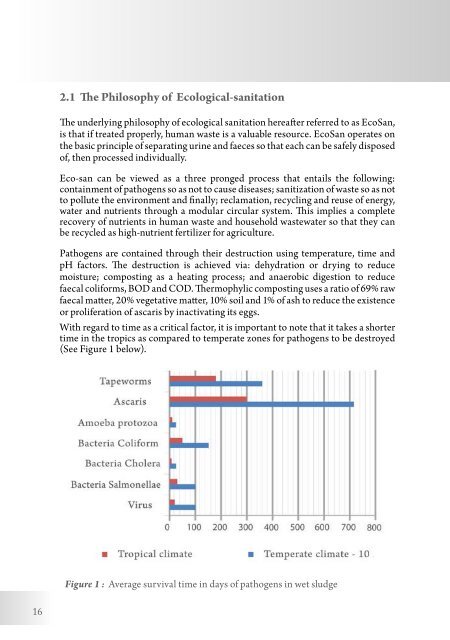Technical Guide to EcoSan Promotion
Technical Guide to EcoSan Promotion
Technical Guide to EcoSan Promotion
You also want an ePaper? Increase the reach of your titles
YUMPU automatically turns print PDFs into web optimized ePapers that Google loves.
2.1 The Philosophy of Ecological-sanitation<br />
The underlying philosophy of ecological sanitation hereafter referred <strong>to</strong> as <strong>EcoSan</strong>,<br />
is that if treated properly, human waste is a valuable resource. <strong>EcoSan</strong> operates on<br />
the basic principle of separating urine and faeces so that each can be safely disposed<br />
of, then processed individually.<br />
Eco-san can be viewed as a three pronged process that entails the following:<br />
containment of pathogens so as not <strong>to</strong> cause diseases; sanitization of waste so as not<br />
<strong>to</strong> pollute the environment and finally; reclamation, recycling and reuse of energy,<br />
water and nutrients through a modular circular system. This implies a complete<br />
recovery of nutrients in human waste and household wastewater so that they can<br />
be recycled as high-nutrient fertilizer for agriculture.<br />
Pathogens are contained through their destruction using temperature, time and<br />
pH fac<strong>to</strong>rs. The destruction is achieved via: dehydration or drying <strong>to</strong> reduce<br />
moisture; composting as a heating process; and anaerobic digestion <strong>to</strong> reduce<br />
faecal coliforms, BOD and COD. Thermophylic composting uses a ratio of 69% raw<br />
faecal matter, 20% vegetative matter, 10% soil and 1% of ash <strong>to</strong> reduce the existence<br />
or proliferation of ascaris by inactivating its eggs.<br />
With regard <strong>to</strong> time as a critical fac<strong>to</strong>r, it is important <strong>to</strong> note that it takes a shorter<br />
time in the tropics as compared <strong>to</strong> temperate zones for pathogens <strong>to</strong> be destroyed<br />
(See Figure 1 below).<br />
Figure 1 : Average survival time in days of pathogens in wet sludge<br />
16

















